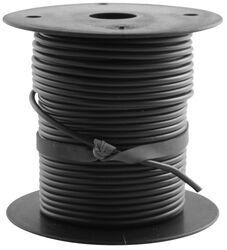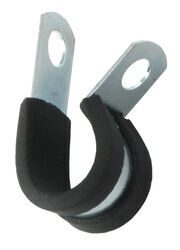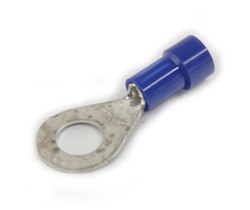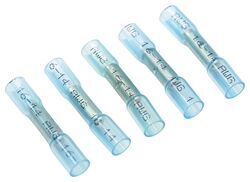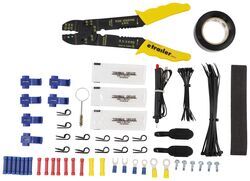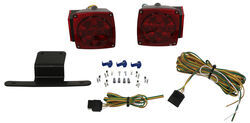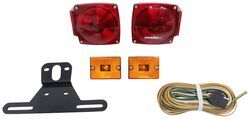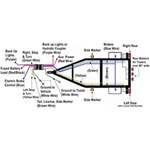
How to Wire a Trailer for Tail Lights
Question:
How do you wire a utility trailer for tail lights, brake lights and turn signals?
asked by: John
Expert Reply:
First, lets make sure you have all of the parts you need to wire a trailer for lights. If you have an old trailer and want to replace everything, I recommend using a kit like our Optronics Tail Light Kit, # TL29BK and our trailer wiring installation kit # HM51020. We also have an LED kit, # TLL9RK.
Step 1 - The trailer connector should extend 2 - 3 feet past the tongue. Attach the ground wire directly to the tongue of the trailer using a self tapping screw # 101131802 and a ring terminal # DW05702-1. If you don't use a tail light kit, you can use a 4-way harness like # A35W42B.
Step 2 - The rest of the wires will run along the frame to the tail light locations. I recommend using wire clamps like # A0500 or you can drill through the frame and use grommets like # SWC8055.
Step 3 - If you have any amber clearance lights at the front of the trailer then you may need a length of jumper wire # 16-1-1 and some butt connectors # DW05744-5. If you are using a wishbone harness with 2 brown wires, then you will not need a jumper wire. The clearance lights will splice into the running light wire (typically the brown wire).
Step 4 - Connect the wires to the tail lights at the back of the trailer. The typical wire colors and functions are listed below.
Brown Wire - Running Lights
Green Wire - Right Turn and Brake Lights
Yellow Wire - Left Turn and Brake Lights
Some trailer lights will use Red and Black wires instead of Brown and Green or Yellow. In that case, then Black wire is typically for running lights and the Red wire is typically for the turn signal and brake lights.
I have attached some typical trailer light wiring diagrams for you to check out.

Products Referenced in This Question
Hex Screw - Self Drilling Unslotted Washer Head #8 x 1/2"
- Accessories and Parts
- Trailer Wiring
- Wiring
- Ground Screw
- Flint Hill Goods
more information >
- Electrical Tools
- Cable Management
- Wire Clips and Clamps
- 1/2 Inch Diameter
- Black
- Redline
more information >
35 Ft 4-Way Trailer Wiring Harness - Wishbone Style - 42" Ground
- Trailer Wiring
- Trailer Connectors
- Trailer End Connector
- 31 Feet and Longer
- Plug and Lead
- 4 Flat
- Optronics
more information >
Ring Terminal -16-14 Gauge - 1/4" Ring ID - Qty. 1
- Wiring
- Wire Connectors
- Ring Terminals
- 1/4 Inch Diameter
- 16-14 Gauge
- Deka
more information >
Deka Heat Shrink Butt Connector - 16-14 Gauge - Nylon Insulation - Blue - Qty 5
- Wiring
- Wire Connectors
- Butt Connectors
- 16-14 Gauge
- Deka
more information >
Hopkins Deluxe Trailer Wiring Installation Kit
- Wiring
- Tools for Wiring
- Wiring Kits
- Installation Kit
- Hopkins
more information >
Snap Bushing Grommet - 7/16" ID, 9/16" OD
- Wiring
- Wiring Protection
- Bushing Grommet
- 7/16 Inch Diameter
- Spectro
more information >
LED Combination Tail Light Kit for Trailers under 80" Wide - Submersible - Driver and Passenger
- Trailer Lights
- Tail Lights
- License Plate
- Rear Reflector
- Side Reflector
- Stop/Turn/Tail
- Square
- Kit
- Surface Mount
- Submersible Lights
- LED Light
- 5L x 5W Inch
- Red
- Optronics
more information >
Product Page this Question was Asked From
Standard Trailer Light Kit with 25' Wire Harness
- Trailer Lights
- Tail Lights
- License Plate
- Rear Reflector
- Side Marker
- Side Reflector
- Stop/Turn/Tail
- Square
- Kit
- Surface Mount
- Non-Submersible Lights
- Incandescent Light
- 5L x 4-1/2W Inch
- Red and Amber
- Optronics
more information >
Featured Help Information
Miscellaneous Media

Continue Researching
- Article: Wiring Trailer Lights with a 4-Way Plug (It's Easier Than You Think)
- Article: Trailer Wiring Diagrams
- Article: Most Popular Wheel Bearings
- Article: 2023 Best Gifts for RVers & Campers
- Article: How to Measure Your Trailer Wheel Bolt Pattern
- Q&A: Dimensions Of Curt Custom Underbed OEM-Style Gooseneck Trailer Hitch C60633
- Article: Trailer Maintenance Schedule
- Q&A: The Function of the Auxiliary 12-Volt Connection on the 7-Way Trailer Connection
- Article: Brake Controller 7- and 4-Way Installation Kit (ETBC7)
- Q&A: Ways to Install New 4-Pole Trailer Connector
- Q&A: ST205/75/15 Spare Wheel And Tire Combo For A 1974 Pull Behind Camper
- Q&A: GloBrite 126R/126Y Red Replacement Light
- Q&A: What is the Difference Between Load Range B and C Trailer Tires
- Q&A: Is Install of B and W Hitch for 2019 Ram 3500 Different from 2500







